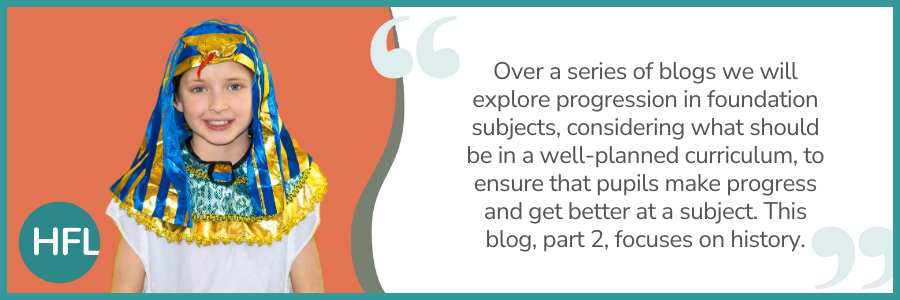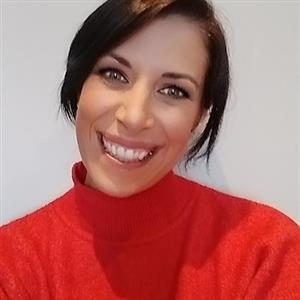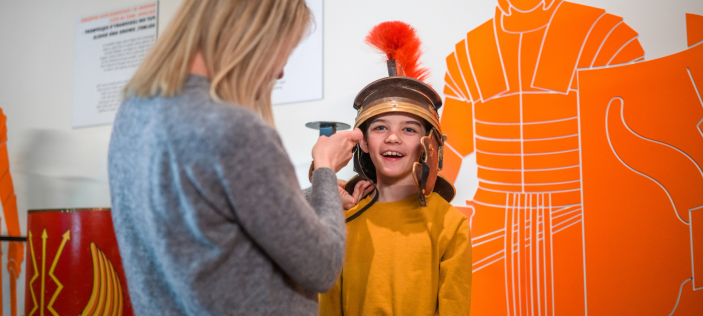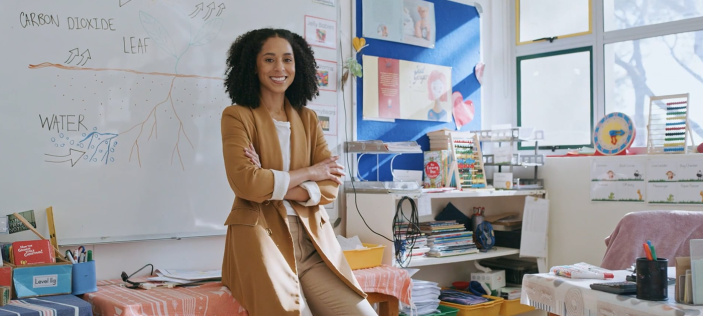
In our previous blog, Progression in foundation subjects – Part 1: Layers of learning, we explored an overview of how children make progress in foundation subjects. In this blog, I aim to address the question; ‘How do children make progress in history?’
As a younger teacher, at the beginning of my career, I used to think that the children in my class had made progress in history when at the end of the unit they were able to memorise important events, dates and people from the unit of work. In my first teaching post, I remember teaching Year 4 children all about the Roman invasion of Britain and being very pleased that they could enact a Roman army attack with their carefully designed and built shield held in the ‘testudo’ formation! Whilst this was a lovely outcome, I remember thinking that there were absolutely no links to the next topic I taught in history. When at the end of the year I needed to reach a judgement about how my children were doing in history; I was flummoxed. If the units of work had no links, how had they made progress? How had they become better at history?
Later in my career, I found myself teaching the same Romans unit of work to a Year 3 class. I also noted that this school taught the Ancient Egyptians in Year 6 whilst the school down the road taught that unit in Year 3. This gave me huge pause for thought and left me with a lot more questions.
How could we say that children were making progress in history if every school taught topics at different times? Was there no hierarchical or linear nature to the progress? Isn’t progress measured by becoming more proficient? Does progress in history just look like an ever-increasing amount of knowledge and vocabulary about different time periods and events, in Britain and abroad?
Recently, I have devoted a lot of time to trying to answer these conundrums. I will attempt to explain my thinking to you in the hope that it may help you begin to answer these questions yourself. I am sure that my thinking is unfinished, but for now, let’s ask ourselves…
What does it really mean to get better at history?
Let’s start by looking at what Ofsted says about the curriculum.
‘The end result of a good, well-taught curriculum is that pupils know more and are able to do more.’
Inspecting the curriculum - GOV.UK (www.gov.uk) Paragraph 5
Personally, I think there are two aspects to this: Firstly, as children move through our planned curriculum, they will accumulate an ever-increasing bank of knowledge about the narrative of Britain; how this place came to be the way it is, what were some of the significant events and individuals who shaped it. They will begin to see our history as a narrative. Similarly, they will also gather knowledge about other worldwide civilisations. But I think this type of ‘knowing more’ is not enough. What links all these projects and units of work? What are the key concepts that straddle all the learning?
So the second aspect of knowing more is about developing understanding of the concepts and threads that hold our history curriculum together.
Learning in history - layers
The diagram above shows the different layers of learning that could be found in history. Across the top we have our units of work or topics that are substantive content led by the national curriculum such as The Romans, Ancient Egyptians, the Great Fire of London etc. The second layer contains the historical concepts that run through every history curriculum. They are a bullet point within the aims of the national curriculum for history (at key stage 1 and 2).
They run through everything in our history learning because, in their simplest essence, they ARE what makes history the subject it is. The study of people and the past is all about the similarities and differences, causes and consequences.
As children move through the history curriculum, they will repeatedly encounter these historical concepts with the aim of developing a richer, deeper and more complex understanding of each one with every new context they meet it in. I think that these concepts are what link all units of work and it is here that you can see if children are getting better at history or just gaining a wider fact base. (Which might help them win a pub quiz but not necessarily help them improve at history!)
Let’s take the example of cause and consequence. How would a child make progress in history in the concept of cause and consequence?
The aim of the history curriculum here, is that children will begin to understand that things have not simply ‘happened’ without reason.
They will learn that historical events are caused by things that occurred before them and these events create changes that have consequences.
I believe that children can make progress within this concept in two ways:
- In a more hierarchical, linear manner; with each year and topic they study, they become more proficient and build their skills incrementally.
- In a manner more like mastery where children develop a rich schema around the concept by meeting it many times in many different contexts throughout the curriculum.
The table below is an example of what a hierarchical progression of the concept of cause and consequence could look like. As children move through the age phases, they become more proficient and adept at understanding and working with cause and consequence. Having an understanding of what these concepts look like in different year groups can really help us pitch our lessons appropriately and can underpin our assessment too.
Progression in Cause and Consequence | |
| EYFS | Begin to understand that their actions have consequences. Begin to explore the idea of cause and consequence through role play, small world, stories and songs, discussing the theme with an adult. |
| 1 | Begin to develop an understanding of why things happened in the past. Choose and use parts of stories and other sources to show that they know and understand key features of events. Study the lives of some significant individuals who contributed to national and international achievements thinking about the consequences of their actions/discoveries etc. |
| 2 | Confidently identify several relevant causes and consequences for some of the main events covered. Study the lives of significant individuals who contributed to national and international achievements thinking about the consequences of their actions/discoveries etc and their impact of Britain. |
| 3 | Begin to devise historically valid questions about cause. Comment on the importance of causes and consequences for some of the key events and developments studied. |
| 4 | Explain with confidence the significance of particular causes and consequences for many of the key events and developments studied. Begin to understand that the consequences of one event can become the causes of another. |
| 5 | Address and devise historically valid questions about cause and consequence. Explain the role and significance of different causes and consequences of a range of events and developments. |
| 6 | Comment independently on the different types of causes and consequences for most of the events covered, including longer- and shorter-term aspects. Understand how some of these causes and consequences are linked to form an historical narrative. |
What could these linear progression statements look like in our classrooms?
The alternative to the linear progression could be schema development.
Consciously planning many opportunities for children to engage with the historical concepts in different contexts, will help their understanding and their schema around these concepts naturally grow and develop.
What could that look like in practice?
Let’s imagine a child in EYFS. They may be encouraged to listen to stories about events and people from the past. An adult may point out some of the key causes of events. They will be busy understanding that their own actions have consequences such as choosing what colour to mix, where to place a new track in their train set, noticing what happens when they push cars over different surfaces. Most of the beginnings of the concept of cause and consequence are grounded in the child’s personal, everyday experience and may fall under the categories of knowledge and understanding of the world, personal development and more.
Moving into KS1, children may learn about what their school used to look like in the past. Through looking at and exploring photos they may comment on the similarities and differences (another historical concept) and begin to notice that the school today is much bigger, has a new part to the building, has more play equipment. We can begin to think about why. More children were born and needed to go to school (cause) and so a bigger building was needed (consequence). We can develop this concept by discussing our new king. Why did we need a new king? After the death of our queen (cause) King Charles III was crowned (consequence). Through simple stories about figures from the past we can talk about why things happened at a very simple level.
Children often learn about the great fire of London. It is a joy to ask children about their learning as inevitably they will tell you with great glee that Samuel Pepys buried his cheese and wine! However, if we want to develop their understanding of history, we may draw attention to some of the causes (houses were made of wood, they were built closely together), and some of the consequences of the fire, (houses were built differently as a result, the fire service began to emerge). We may remind children where they have encountered this concept in prior learning thus strengthening their schema.
In KS2, children will encounter early history when they study the Stone age to Iron age. Possible contexts for developing their understanding of cause and consequence here may be, the discovery of metal (cause) and how that led to better farm tools, ultimately more food and improved health and longevity over time (consequences). Another example of this historical concept may be to examine the causes of the Roman invasion of Britain. We might investigate with children why the Romans invaded, looking at reasons such as establishing a bigger empire, owning more crops and slaves, having access to more metals and other natural resources (causes and a direct link to the consequences learned about in the iron age). We could then look at evidence of the consequences for Britain by examining the new roads, towns, religion, ways of reading and counting etc (consequences).
In looking at the wider world, we could investigate how the ancient Kingdom of Benin became so wealthy, (consequence) by looking at the Benin bronzes, foods and spices etc (causes) that attracted European visits. Thinking about social, political, religious, economic and military causes of significant events and discoveries are fantastic opportunities for children to engage with history in a meaningful way and develop their schema around this concept.
Of course, if we want these teaching moments to be meaningful, we need to draw the children’s attention to the concept and where they have met it before. Highlighting the prior learning and where they will meet the concept again in subsequent topics, ensures that a constant thread is pulled through the history curriculum enabling children to progress.
We need to continually draw the children’s attention to the concept and where they have met it before.
In summary, how do children get better at history? Here are three factors that leaders may wish to think about:-
- Children can get better and make progress within the concepts that underpin history hierarchically, if these are planned for in an incremental way, as show in the table above.
- They can develop a rich schema around these concepts, in order to master the ideas, by purposefully meeting the concept in many contexts throughout the curriculum, with the adult drawing their attention to the concepts as they are revisited.
- The points above might work best when we purposefully plan the opportunities and highlight them to the children. ‘Do you remember when you looked at some of the causes of the great fire of London? Today we are going to look at the causes of…’, which might require a combination of both points 1 and 2.
In your school; is there an understanding of the historical concepts that underpin learning in history (such as similarity and difference, cause and consequence)? Do adults purposefully draw pupils’ attention to these concepts (to allow pupils to develop schema)? Do adults understand how this learning might grow and develop over time as pupils mature (thinking about the progression table idea)?
In subsequent blogs, we will exemplify further concepts in other foundation subjects asking the key question, what does it mean to make progress?



